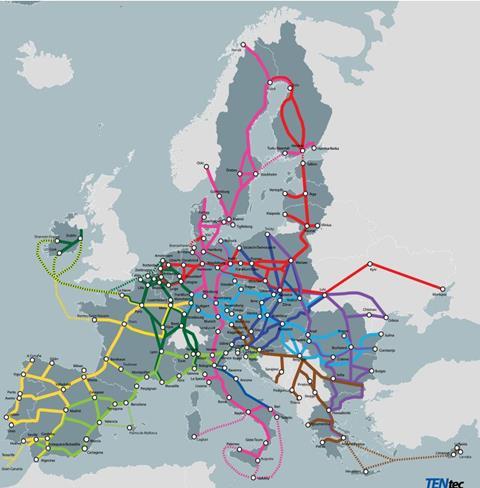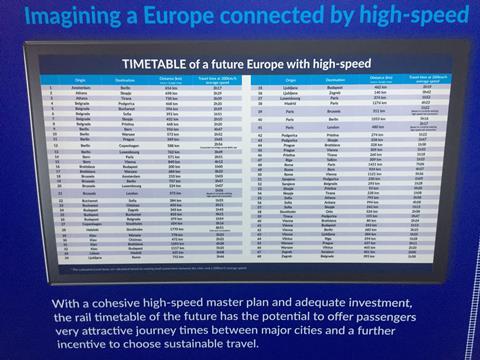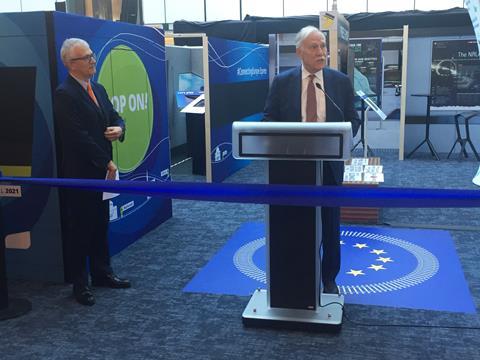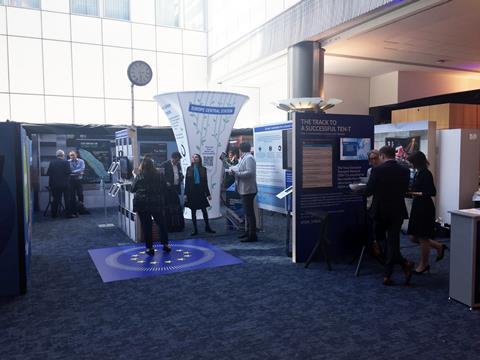
EUROPE: A clear strategy and implementation timescale are essential for delivery of an expanded TEN-T rail network over the next two decades, according to Dominique Riquet, Co-Rapporteur on the TEN-T revision proposals for the European Parliament’s Transport & Tourism Committee.
Speaking at an event in the European Parliament organised by the Community of European Railway & Infrastructure Companies on October 11, Riquet said the TRAN Committee would shortly be publishing its response to the proposed revision of the Regulation on the Trans-European Transport Network, put forward by the European Commission on December 14 2021 with further amendments announced in July to reflect the impact of the Russian invasion of Ukraine.
Urging a rapid adoption of the revised strategy, Riquet warned that some EU member states might seek to ‘water down’ key elements of the proposals.
Entitled ‘The track to a successful TEN-T for a sustainably connected Europe’, the CER event brought together representatives from the European institutions and the rail sector, and marked the opening of an exhibition in the Parliament buildings setting out the association’s vision for rail development over the coming decades. This featured a range of infrastructure initiatives, from major new line projects to missing cross-border links, as well as technical innovations that would support enhanced passenger and freight services and contribute to the modal shift objectives in the EU’s Green Deal package.

The TEN-T revision sets ‘ambitious infrastructure targets’, with a three-stage development timescale. This would see the TEN-T Core Network completed by 2030, an Extended Core Network by 2040 and the so-called Comprehensive Network by 2050.
CER Executive Director Alberto Mazzola said the proposal represented ‘a great improvement on the current situation’, pointing out the importance of connectivity and regional development including last mile-connections, enhanced urban nodes and a more multimodal focus.
Suggesting that ‘the infrastructure of the TEN-T is the soul of the European Union’, Riquet said rail was a way to exchange people and goods between member states, and share culture across Europe. He wanted to ‘increase the quantity and quality of those exchanges’, which required an interoperable, multi-modal and environmentally performing transport network, which was resilient to both geopolitics and the impacts of climate change.
High speed vision
However, CER remains concerned that there is insufficient focus on high speed rail as a climate-friendly alternative to air travel. The association wants to see a High Speed Masterplan for the creation of an interoperable European network linking European capitals and major cities, as well as airports, to support the expansion of international passenger services.
Speaking for the passenger operators, Trenitalia CEO Luigi Corradi said the sector and the Commission had a common goal ‘to move more people by train’, adding that ‘the formula for success is to work together’.
Endorsing calls for a greater focus on cross-border opportunities, he noted that international passenger traffic to and from Italy had recovered faster than other businesses and was now running at around 30% above pre-pandemic levels.
Pointing out the success of Trenitalia’s Milano – Paris trains in their first year of operation, Corradi said Iryo high speed services in Spain would be starting ‘in about a month’. But while the trains would link Madrid with Barcelona, Sevilla and Malagá, he asked rhetorically ‘why can’t we go to Portugal?’

Welcoming CER’s vision for a pan-European high speed network, DG Move’s Acting Deputy Director-General and Director for Investment Herald Ruitjers said almost all member states now had high speed rail proposals, highlighting the ambitions plans of the Czech Republic, which currently holds the rotating EU presidency. The Commission believes that rail could be competitive with air travel for journey times of up to 6 h or 7 h, while accepting that some form of decarbonised air travel will be needed for distances over 1 000 km.
However, he felt that ‘rail still has a long way to go’, in terms of implementing the provisions of the four railway packages, and opening national markets, noting that the Commission was still seeing ‘behaviours that are not in synch with what we need to achieve’, particularly around cross-border services and through ticketing.
Describing the July 23 decision to add Ukraine and Moldova to the TEN-T network and call for greater use of 1 435 mm gauge on international corridors as ‘a bold proposal from the Commission’, Ruitjers said it was shocking that there were still 4 million lorries a year crossing the Pyrenees between Spain and France, and that there was no international passenger service between Madrid and Lisboa.
Freight priorities
Speaking as head of the Rail Freight Forward coalition, Rail Cargo Group CEO Clemens Först told the conference that the sector had a clear strategy for growing rail freight’s market share in line with the EU’s wider modal shift objectives.
However, this would need greater infrastructure capacity and harmonised technical and operational standards in order to make rail competitive with other modes.
‘In the past we have talked a lot about interoperability, but today the life and death issue is capacity’, he explained. Looking to the ongoing TTR timetable revision programme, he said operators were looking for a minimum of two paths for 740 m long freight trains per hour on each TEN-T corridor, with the P400 loading gauge providing clearance for intermodal traffic.

Introducing the Rail Freight Forward 2.0 vision, Först said the coalition had five key targets, including a comprehensive roll-out of the digital automatic coupling and more digitalisation of operating systems such as capacity management. Looking forward to the eventual goal of automatic train operation, he said rapid deployment of ERTMS across the entire European rail network was ‘the right thing to do, for all the reasons’. However, he warned that freight operators faced an ongoing challenge in funding the fitment of ETCS onboard units.
Funding challenge
CER wants to see more synergies between European co-ordinators overseeing all traffic on the network’s major corridors and specific rail freight governance, as well as infrastructure requirements with sound targets and deadlines.
However, the association is concerned that there is insufficient funding available to the meet the ‘ambitious and reinforced targets and deadlines’, in the TEN-T revision, while the lengthy timescale goes beyond the EU’s current multiannual financial framework which sets the budget for the Connecting Europe Facility. ‘It is essential to lock in sufficient funds to make sure that the development of the rail network of the TEN-T is not compromised’, Mazzola insisted.
Ruijters pointed out that rail was benefiting from around 70% of all CEF funding, including the ‘precient’ military mobility allocation of €6bn established before the Ukraine crisis. ‘More than 1 000 projects in the portfolio have been or are being implemented’, he emphasised. ‘The implementation of the Core Network is going ahead, and it will be a good deployment’, he believed.
Noting that future European funding would be dependent on EU member states, he suggested that ‘almost all member states have a clear view of what should be realised in the MFF for 2028-34 and 2035-41’, which would be ‘the powerhouse for the future debate’.
Riquet suggested that some member states were ‘turning a blind eye’ to protect their national monopolies, which had isolated their networks, disrupting European policy and ignoring opportunities to attract innovative financing.

Accepting that the CEF budget allocation would be insufficient to deliver all the TEN-T objectives, he noted that some member states were able to invest, citing €200bn for German rail development promised by German Chancellor Olaf Schulz. However, he worried that there was ‘no symmetry’ between the ability (or willingness) of member states to support the upgrading of their railway infrastructure.
Welcoming the positive support for the TEN-T revision, Ruitjers said the proposals floated during the discussion offered ‘a very good starting point’ to see which additions could be taken forward. Calling for stronger governance of cross-border projects in particular, he warned that ‘we are too weak’ in legislative terms and would ‘need to fight the member states on this’. When it came to getting the TEN-T revision through the legislative process, he feared that ‘the debate will be extremely difficult’.
Urging the European Parliament to endorse the TRAN Committee’s report, Riquet said he was also keen to ensure that the Commission’s revision proposals were not watered down during the legislative process. However, in terms of adding to the vision, he recognised the wider concerns over funding and cost control, commenting that ‘rail is not so cheap’.
‘Rail is the transport mode that has the highest potential to decarbonise mobility’, Riquet concluded. ‘In order to reach our modal shift goal, thousands of kilometres of lines will need to be modernised or built. The TEN-T strategy must ensure that they are financed and built to common standards, in the best possible locations.’

















